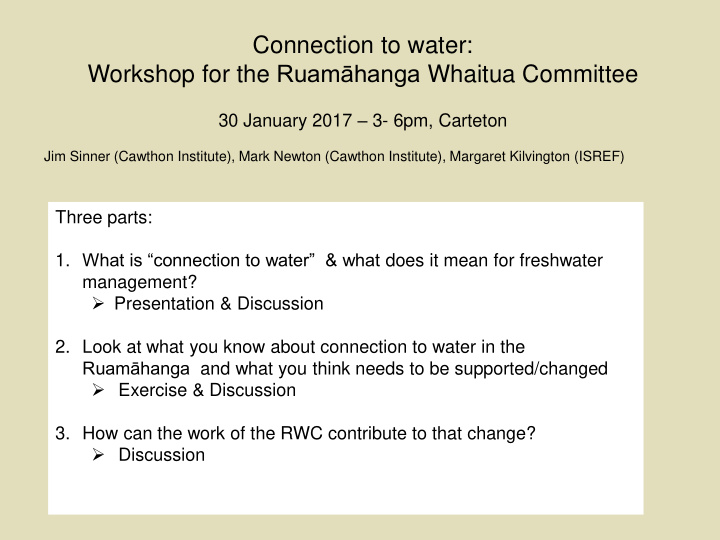



Connection to water: Workshop for the Ruamāhanga Whaitua Committee 30 January 2017 – 3- 6pm, Carteton Jim Sinner (Cawthon Institute), Mark Newton (Cawthon Institute), Margaret Kilvington (ISREF) Three parts: 1. What is “connection to water” & what does it mean for freshwater management? Presentation & Discussion 2. Look at what you know about connection to water in the Ruamāhanga and what you think needs to be supported/changed Exercise & Discussion 3. How can the work of the RWC contribute to that change? Discussion
SENSE OF PLACE IN FRESHWATER MANAGEMENT MARK NEWTON 30 JANUARY, 2017
WHAT IS SENSE OF PLACE? • Connection to water links to sense of place Defined as: peoples ’ feelings of deeper connection, comfort, belonging, • and attachment to special places. • Two dimensions of sense of place: Place attachment – emotional connection Place dependence – functional connection • Also, evidence of a shared/collective sense of place • Sense of place is the psychological and functional attachment to a place
WHY IS SENSE OF PLACE IMPORTANT? • Contributes to: Personal identity and psychological wellbeing Pro-environmental behaviour A shared sense of community purpose, wellbeing, unity • Understanding the attributes comprising sense of place enables planning decisions that better meet people’s needs (e.g. emotional, economic , cultural, social)
LINK BETWEEN SENSE OF PLACE AND ENVIRONMENTAL BEHAVIOUR Many studies show a link between sense of place and environmental • behaviour • Encourages place-protective behaviour But, there are many influences on behaviour • • Behaviour can be unexpected Source: Kilvington et al 2016
HOW TO INCREASE SENSE OF PLACE • Direct engagement with a place over long periods of time or frequent place visits – sense of place develops strongly in children Participation in environmental stewardship activities at sites that are • being restored, or to natural areas in general • Social interactions at a place Learning place meanings from written, oral, and other sources, including • communication with other people • The cultivation and sharing of place meanings through, e.g. stories, myths, literature, promotional materials, folklore, paintings, music, dance, films, history, casual conversations, and memory ‘ Improving’ the physical environment of a place …? •
DESIGNING POLICIES/PLANS TO INCREASE SENSE OF PLACE Sense of place differs between groups – age groups, cultural groups, • people of different residential status… • Designing interventions to improve sense of place requires ? consideration of the attributes of a place with which people connect Photo credit: Jim Sinner
REFERENCES • Kilvington M, Allen W, Sinner J 2016. Understanding how change is motivated workshop for water management decision makers Output from work contracted by Greater Wellington Regional Council, in support of the Ruamāhanga Whaitua water management committee. (http://www.gw.govt.nz/ruamahanga-whaitua/); in conjunction with the Wheel of Water Research programme (https://wheelofwater.wordpress.com/)
1. The concept of “connection ? to water” & what it means for freshwater management 1. What could be the use/value/importance of this idea to your work as a group?
1. The concept of “connection ? to water” & what it means for freshwater management 1. What could be the use/value/importance of this idea to your work as a group? 2. Are you interested in sense of place as an objective in itself? a means of promoting pro-environment behaviour? A means of creating shared community purpose? . Some other reason?
2. Connection to water in the Ruamāhanga : What does it look like and what needs to be supported/changed? Exercise & Discussion
Exercise & Discussion Outline 1. Think about one or two places in the Wairarapa that you are attached to . Write on cards – or use images – put up on wall 2. Identify the things that make this place special to you (up to five). Write each of these on a separate card. Put up on the wall 3. Cluster and compare Themes? Similarities? Differences? Are there some things that stand out and could be targeted?
Exercise & Discussion Outline 4. What about the places where attachment has diminished? Identify these – locations/images on cards on wall Five reasons for why this is has happened – on cards on wall Cluster and compare Themes? Similarities? Differences? Are there some things that stand out and could be targeted? 5. How typical do you think your views are in the catchment?
3. How the work of the RWC can contribute to improving connection to water?
3. How the work of the RWC can contribute to improving connection to water? 1. Are there some people/places/values – you can identify as needing change in order to improve connection to water? Places Values Groups/People/Organisations 2. What is the nature of this change? 3. What are the implications for the WIP? Enable remove barriers to change Encourage provides incentives (legal, social etc) Create Consistency leading organisations are in line with the change Engage Connect people and encourage collective action
What do you take away from this workshop? Anything you want written up?
Recommend
More recommend